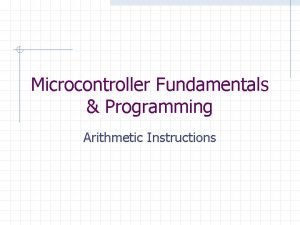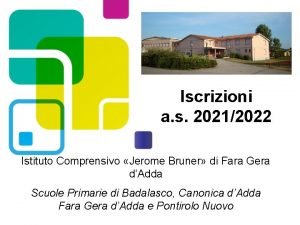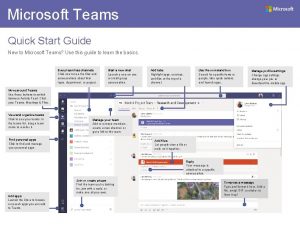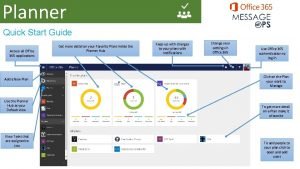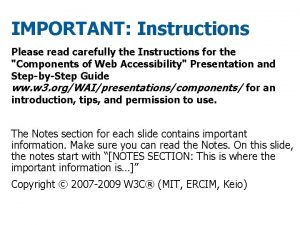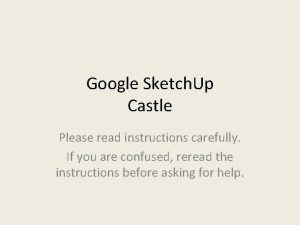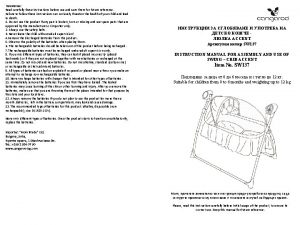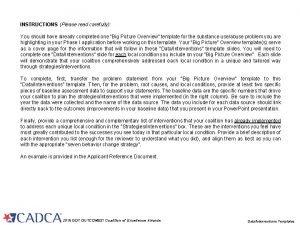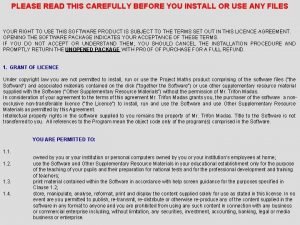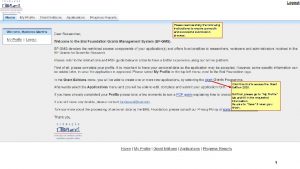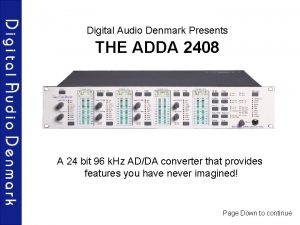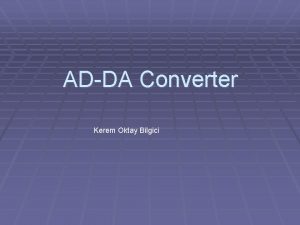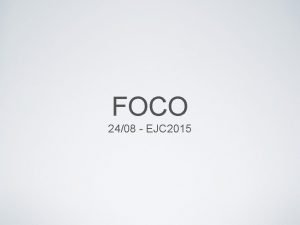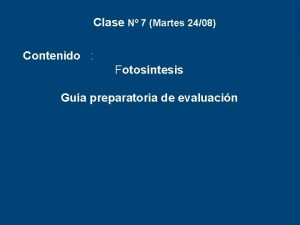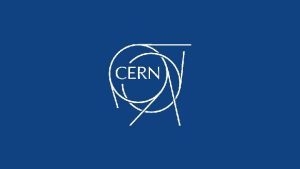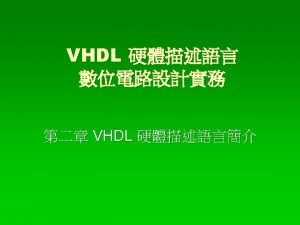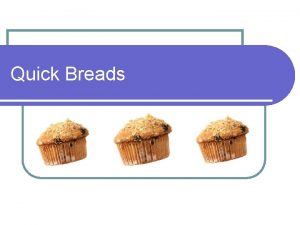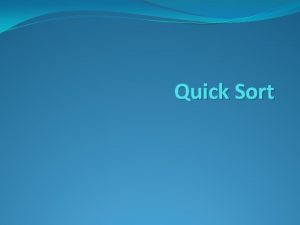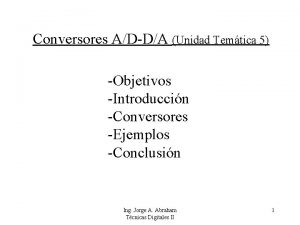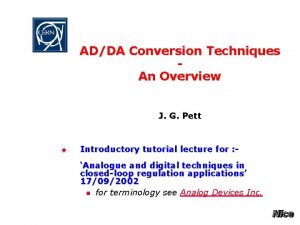THE ADDA 2408 Quick Start Please read the
























- Slides: 24

THE ADDA 2408 “Quick. Start” Please read the manual and/or ADDA 2408 presentation for further information, both available at www. digitalaudio. dk 1

Contents 3. Connecting the cables 4. Turn on the ADDA 2408 5. Basic structure 6. Overview 7. Short Cuts 8. AD-DD Source Button 9. World-Class Mic Preamp 10. Synchronization Options 11. Delay, Low cut and Phase 12. The DA Source Button 13. The Monitor Mixer 14. Head Phone Amp 15. Sync alarm 16. Overview: The Menu Structure 17. Precise Line Level Adjustment 18. I/O modules 19. The 4 ch. DA converter interface 20. The Pro. Tools Mix 24 compatible I/O’s. 21. Pro. Tools HD 22. The TDIF interface 23. The ADAT interface 24. The AES, S/PDIF interfaces 2

Connecting the cables 1. Place the unit on a dry surface or in a rack with plenty of space for ventilation. 2. Connect the analog cables 3. Connect the digital cables to the I/O modules and the sync cables. 4. Connect the power cord Power cord Synchronisation Analog stereo output or AES Analog input 1 -8 Digital and analog I/O slots for digital I/O and analog outputs 3

Turn on the ADDA 2408 Turn on the power button on the front panel. For turning off the power you need to press the button for about 3 sec. Ensure that the main power switch is on 4

Basic structure With the DA source button you select the source for the built in 8/2 mixer and for your analog outputs. You can choose between the input selected on the AD-D button or any of the digital interfaces. If a valid digital signal is present the green “Carrier” LED will light up. If you have installed a Pro. Tools Mix 24 compatible I/O card you have to choose this interface as Multi 1 or Multi 2. With the AD-D source button you can choose the input (for 2 channels at a time) which will be availably as a digital signal on all digital multi-channel outputs with the samplerate, dither and sync selected at the sample-rate, dither and sync buttons. If you choose an analog signal the converter will work as an A/D converter. If you choose a digital signal the converter will work as a sample-rate and/or a format converter. If the incoming digital signal is not in sync with the converter it will be detected and the signal will be sample-rate converted. If a valid digital signal is present the green ‘Carrier’ LED will light up. 5

Overview Power button with Security locks, (the main power can only be turned off by a continuous 3 seconds press on the power button). Level/data controls for all 8 channels. LCD display for all stereo channels. AD-D source button for selection between the analog or digital inputs (2 channels at the time) Short cuts button for Input/monitor, Solo, Pan, Delay, Low cut, and Phase inversion. Detailed 21 LED peak metering measuring the digital or analog input. Sample-rate, sync and dither buttons A/D-D/A and Systems button DA source button High quality analog headphone amplifier. The Level/data controls are used for all selections and adjustments. For adjustment of a parameter related to a channel (1 -8) use the corresponding Level/data controls. For adjustment of an ‘over-all’ parameter use the Level/data controls and the LCD display for channels 7 & 8. All primary functions are available by pressing only one button! 6

Short Cuts Input/monitor level Solo Pan Delay Level/data knobs for the 8 channels Low cut Phase AD-DD and Monitor menu The short cut buttons provide fast access to the primary functions in the AD-DD and Monitor menus. The short cuts are only active when the short cut button is pressed. After releasing a short cut button the ADDA 2408 returns to the function prior to short cut activation. If for instance the Mic gain in d. B is selected and a short cut is activated, the corresponding function may be adjusted using the Level/Data knob for one or more channels. By releasing the short cut button the ADDA 2408 returns to the Mic gain in d. B function. It is therefore easy at all times to identify the active functions of the ADDA 2408. . It is recommended to set the ADDA 2408 into Mic gain in d. B or Monitor level mode while recording. 7

AD-DD Source Button AD-D source button With the AD-DD source button you can choose between the different analog or digital interfaces for two channels at a time. The selected input will be available on all digital outputs with the sample-rate, dither and synchronization chosen at the Sample-rate, Dither and Sync buttons. This way the unit can be either an A/D, a sample-rate, or a format converter between the digital I/O’s mounted in the ADDA 2408. If the selected digital input has a different sample-rate or synchronization than the sample-rate and synchronization chosen at the Sample-rate and Sync buttons, the unit will auto-detect the 8 difference and use the built in sample-rate converter automatically.

World-Class Mic Preamp Gain adjustment knobs for all 8 channels 8 Ultra-High quality Mic Pre amps with phantom power, low cut filter and phase inversion. The Mic Preamp itself has a very low equivalent input noise at - 130 d. B at +24 d. B gain. Analog gain can be adjusted in increments of 3 d. B. The following analog gain steps are available: -18, - 12 , -6, - 3, 0, + 3, + 6, + 9, + 12, + 15, + 18, + 21, and + 24 d. B of analog gain, for at total of 42 d. B analog gain adjustment. This enables the user to scale any common microphone level properly into the 117 d. B dynamic range provided by the A/D converter. In between the analogue gain steps, the gain can be adjusted digitally in steps of 0. 5 d. B for a maximum of +72 d. B gain. The maximum input level is 24 d. Bu. The input impedance is 15 k allowing the Mic Preamps to handle line signals as well. 9

Synchronization Options The Sync button The ADDA 2408 accepts external synchronization from the following sources: AES 11, Word Clock, Video Clock or a digital input signal. If the digital input is selected as the sync source, it will be the signal chosen at the DA source button which will also be used as the sync source. It is recommended to use the internal synchronization of the ADDA 2408 or a master studio clock of similar quality as the synchronization source for the ADDA 2408. The frequency used for sampling will always be present as a Word Clock signal at the Word Clock output. This way the ADDA 2408 can be used as a synchronization converter between AES 11, Video Clock, Digital input and Word Clock. If a Pro. Tools compatible I/O card is mounted in the ADDA 2408, synchronization can be set to Super Clock input , (at the I/O card) and a Super Clock output will also be available. A PLL circuit is cleaning up minor errors (jitter) in the incoming sync signal. Because of the very precise internal oscillators (5 ppm) the ADDA 2408 can be used as a studio master sync generator. 10

Delay, Low cut and Phase Delay shortcut Lowcut shortcut Phase shortcut AD-DD menu Adjustment knobs for one or all 8 channels A delay from 0 to 100 ms. can be added to all channels chosen at the AD-DD source button separately. Use the Delay short cut, or find the delay setting in the AD-DD menu. The main application for the Delay setting is to bring a multi microphone set-up into correct phase. Another application is to set the delay of the audio signal to match the video delay when mixing digital video. Low-cut can be added to an analog signal on one or more channels. Use the Low cut shortcut or find the Low-cut settings in the AD-DD menu. Phase inversion can be added to all channels chosen at the AD-DD source button separately. Use the Phase short-cut or find the Phase setting in the AD-DD menu. 11

The DA Source Button DA source button With the DA source button it is possible to choose the source for the D/A analog outputs. Selection can be made between the outputs from the AD-DD converter, selected with the ADDD button or directly from one of the digital inputs. The input chosen at the DA source button will be used as the source for the monitor mixer, and if one or two expansion D/A cards are mounted in the ADDA 2408, the selected signal will be present at these analog outputs as well. If you want to use the ADDA 2408 for monitoring 5. 1, you have to install one 4 channel D/A expansion card. (Use the monitor mixer to route channel 5 and 6 to the analog stereo output. The 4 channel D/A expansion card will monitor channels 1 to 4). 12

The Monitor Mixer Solo shortcut Pan shortcut The Monitor menu button The monitor Mixer can be used to mix down the 8 channels chosen at the DA Source button, into a stereo mix. At the Monitor mixer you can adjust output level, pan, solo, master level, solo level, and solo pre/post. For two channels at a time (1/2, 3/4, 5/6, or/and 7/8) it is possible to chose between a normal L/R output or a MS decoding of the signal. The level for M and S can be adjusted at the Level/Data knobs. The output level, pan, and solo functions can be reached at the short cuts. The master level can be adjusted at the Phones knobs. The output from the monitor mixer will be available on the stereo XLR outputs on the back panel, and the Phones output on the front panel. It is possible to change the left analog XLR output on the back panel into a digital AES output in the monitor menu. The monitor output of two or more ADDA 2408’s can be linked together by connecting the AES output from one ADDA 2408 to the AES 11 sync input of another ADDA 2408, and so on. 13

Head Phone Amp A high quality analog headphone amplifier with 1/4 inch jack is located on the front panel. The source for the headphone output is the stereo mix from the monitor mixer. The headphone output level on the front panel and the stereo XLR line connectors on the back panel, may be adjusted individually. However within the monitor menu it is possible to link the level of XLR outputs on the back panel to the Phones level knob on the front panel The head phone amplifier is powerful and capable of feeding up to 6 sets of 600 headphones with a high monitoring level. 14

Sync alarm The ADDA 2408 can detect if the converter is in correct synchronization with your hard disk recording system. It is doing so by counting the incoming and outgoing samples on the digital I/O cards. If the connected hard disk recording system is not in sync with the converter, the sync alarm will light up and the LED for the digital interface at the DA source will flash. This can happen if both the converter and the hard disk recording system are set to internal sync. 15

Overview: The Menu Structure The AD-DD button: Line, Mic Gain in d. B, or Digital input Low cut Phase inversion Delay AD-DD Mute The Restore button: Restores all AD-DD and Monitor button settings to default values The Peak meter button: AD-D source/DA source Use the level/Data knobs for channel 7 & 8 and the Enter button in order to change the settings in the different menu's. The LCD display for Channels 7 & 8 will show the settings for the different menu settings. The System button: I/O options (TDIF) Clock Output Max Line level Sync alarm on/off Display Contrast The Monitor button: Monitor Level in d. B Monitor Mute Monitor Pan Monitor Solo L/R or MS listening Master Level /d. B Solo Pre/Post L/R or AES Link L/R level to Phones 16

Precise Line Level Adjustment Line level adjustment knobs for all 8 input channels Line level adjustment knobs for stereo analog output The output line level can be adjusted on the back panel to a reference level for 0 d. BFS between + 12 and + 27 d. Bu. The input line level is set in the System menu between +12 and +21 or +21 and 30 d. Bu. Precise adjustment is done at the line level adjustment knobs on the back panel. If another analog input level is required, the Mic input can be selected, since this input will accept line levels as well. 17

I/O modules A variety of expantion cards can be added to the ADDA 2408, including: * Dual AES 3 -S/PDIF digital I/O * 8 ch. AES 3 digital I/O * 8 ch. TDIF digital I/O * 8 ch. Pro. Tools Mix 24 compatible I/O * 8 ch. ADAT SMUX compatible I/O * 4 ch. D/A converter 18

The 4 ch. DA converter interface 1. One or two DA interfaces can be mounted in the ADDA 2408 for additional 4 or 8 ch. of analog outputs. The DADI/O-4 DAC-XLR or the DADI/O-4 DAC-XLR-L. On both cards the output line level can be adjusted to a reference level for 0 d. BFS between + 12 and + 27 d. Bu via individual potentiometers on the modules. 2. The DADI/O-4 DAC-XLR can monitor the AD-DD source or the DA source. It also has build in output level control which can be set to individual levels for all channels and with a master level controled via the headphone knob. Together with the 2 stereo outputs already in the ADDA 2408 one DADI/O 4 DAC-XLR can be used as monitor output with output level control for 5. 1 applications. 3. The DADI/O-4 DAC-XLR-L can only monitor the digital inputs. The output level can not be controled. One or two DADI/O-4 DAC-XLR-L can be mounted in the ADDA 2408 for 4 or 8 ch. of analog outputs. . 19

The Pro. Tools Mix 24 compatible I/O’s. 1. 2. 3. 4. 5. 6. 7. . If a Pro. Tools compatible interface is mounted in the ADDA 2408 you can connect this interface on the ADDA 2408 directly to the computer, the same way you normally connect your 888/24 I/O's. Turn on the power on the ADDA 2408. Then start the Pro. Tools system. In the Hardware set-up menu of the Pro. Tools system the ADDA 2408 is showing itself as an 888 /24 interface, and has to be set up as an 888 /24 interface. However the ADDA 2408 (888 /24 ) has to be set to internal sync in the Pro. Tools menu. At the ADDA 2408 the Pro. Tools interface will be identified as multi 1 or multi 2. The sync source for the ADDA 2408 must be chosen on the front panel of the ADDA 2408. Generally we recommend the ADDA 2408 as the master clock generator, because of its much more accurate oscillators (5 ppm) compared to most units. We also recommend Word Clock instead of Super Clock where possible, because Super Clock is 256 times faster than Word Clock and therefore more sensitive to Jitter. On the Pro. Tools Mix 24 compatible interface you will also find two BNC connectors called ‘In’ and ‘Out’. These connectors are for Super Clock in/out. If you want to synchronize the ADDA 2408 via Super Clock, connect a valid Super Clock signal to In and choose Super Clock at the Sync button on the front panel. If you want to synchronize an 888 I/O or USD from the ADDA 2408, connect the Super Clock input on one of these units to the Super Clock out at the Pro. Tools Mix 24 compatible interface mounted in the ADDA 2408. 20

Pro. Tools HD. 1. The ADDA 2408 can be connected to Pro. Tools HD system via Pro. Tools 192 Digital I/O (without Pro. Tools converters) , or Pro. Tools 192 I/O (with Pro. Tools converters). 2. Generally we recommend the ADDA 2408 as the master clock generator, because of its much more accurate oscillators (5 ppm) compared to most units. However the ADDA 2408 can be synchronized via Word Clock and Super Clock as well. 3. We recommend Word Clock instead of Super Clock where possible, because Super Clock is 256 times faster than Word Clock and therefore more sensitive to Jitter. 4. At 96 k. Hz it is necessary for the ADDA 2408 to be mounted with an 8 channel AES interface. Connect this interface to the AES interface mounted in the Pro. Tools system. You need a D-Sub break-out cable from the ADDA 2408 and a D-Sub break -out cable from the Pro. Tools HD. Some of the 8 channel AES interfaces can be configured with the Pro. Tools pinning at the D-Sub. In this case you can connect the ADDA 2408 directly to the Pro. Tools system with a normal 25 Pin D-Sub cable. 5. It is also possibly to connect the ADDA 2408 to Pro. Tools HD with a TDIF interface or a Pro. Tools Mix 24 compatible interface, solely at 44. 1 or 48 k. Hz. The Pro. Tools Mix 24 compatible interface can be connected to the legacy port on the Pro. Tools HD system. Within the Pro. Tools system the ADDA 2408 has to be set up as an 888/24. 21

The TDIF interface 1. 2. 3. 4. 5. If a TDIF interface is mounted in the ADDA 2408 you can connect this interface on the ADDA 2408 to a digital device with TDIF interface. There are 3 different configurations of the TDIF interface: TDIF 1, TDIF 96 and TDIF DS. In the system menu (I/O options) on the front panel (LCD display 7 & 8) you can chose which TDIF format you will use. At 44. 1 and 48 k. Hz there are no differences between the formats. At these sample rates you must connect the TDIF to the left TDIF connector on the ADDA 2408 TDIF interface. At 88. 1 and 96 k. Hz the options are as follows: TDIF 1: The left connector is carrying channels 1 -4 I/O, the right connector is carrying channels 5 -8 I/O. This gives you the opportunity to use two TASCAM 8 track 48 k. Hz recorders in order to record 8 channels at 96 k. Hz. The interface does not carry sample rate information, so you must chose the right sample-rate at both the converter and the TDIF machine. Some old TDIF machines need Word Clock in order to run on ext. sync. Connect the WC out on the back panel of the ADDA 2408 to the WC in on the TASCAM recorder, set the ADDA 2408 to internal sync and set the TASCAM machine to WC sync. TDIF 96: This is the new TASCAM dual wire 96 k. Hz format. The left connector carries channels 1 -4 I/O, the right connector carries 5 -8 I/O. The emphasis bits in the signal are used to send sample rate information. Use only this format if you have a new TASCAM device like the MX 2424 which can work with TDIF 96. It is not necessary to connect word clock, although it is highly recommended, in order to avoid jitter. TDIF DS: This format is for Sound. Scape Red systems exclusively. It is a single wire format at 96 k. Hz. Connect the Left TDIF connector on the ADDA 2408 to your Sound. Scape Red system. Set the Sound. Scape system to digital input sync and the ADDA 2408 to internal sync. If you have more than one ADDA 2408, you can use one as the master and synchronize the rest via Word Clock in/out on the back panel of the ADDA 2408’s. 22

The ADAT interface 1. The ADAT I/O interface is a dual wire 96 k. Hz SMUX interface. If mounted in the ADDA 2408 it will identify itself as ADAT in the AD-DD source and the DA source menu. . 23

The AES, S/PDIF interfaces 1. Two types of AES interfaces can be mounted in the ADDA 2408. An 8 channel AES I/O with a D-sub connector, or the stereo AES / S/PDIF / Optical S/PDIF interface. Both interfaces is single wire at 96 k. Hz. If both interfaces is mounted in the same unit, the 8 channel AES will identified itself as multi 1 or multi 2. The 8 channel AES I/O: If you have mounted the 8 channel AES I/O, you probably need a D-SUB to XLR break-out cable. However if you are using a Merging Pyramix system you can connect the DSub on the ADDA 2408 directly pin wise 1 -1 to D-Sub on the Merging system. In order to connect pin wise 1 -1 you need an adapter and an 25 pin D-sub cable. 3. The stereo AES, S/PDIF, Optical I/O: If you have mounted the stereo AES, S/PDIF / Optical S/PDIF interface you can chose any of these formats as an input at the AD-DD source button for the different channels for a maximum of 6 ch. digital inputs. The output of the AES, S/PDIF and Optical S/PDIF interface will always be the chosen input at channels 1 & 2 at the AD-DD source button. If you need an AES format mix of all 8 channels you can not use this interface. Instead you must connect an AES signal to the “L” or AES 2 output (to the left on the back panel) use the built in mixer, and set the monitor output to AES in the monitor menu. . 24
 Quickchek menu
Quickchek menu Quick find vs quick union
Quick find vs quick union Parco adda
Parco adda Adda vietnam
Adda vietnam Difference between adca and adda
Difference between adca and adda Ic fara gera d'adda
Ic fara gera d'adda Microsoft teams quick start guide
Microsoft teams quick start guide Teams quick start guide
Teams quick start guide Proteus quick start guide
Proteus quick start guide Microsoft planner quick start guide
Microsoft planner quick start guide Will you please be quiet please summary
Will you please be quiet please summary Please start the
Please start the But we gotta start somewhere
But we gotta start somewhere Jump start triage algorithm
Jump start triage algorithm Read aloud the following sentences
Read aloud the following sentences Please read
Please read Please read carefully the instructions
Please read carefully the instructions Carefully castle
Carefully castle Please read instructions carefully before use
Please read instructions carefully before use Please read carefully the instructions
Please read carefully the instructions Trifon madas death
Trifon madas death Please read our
Please read our Please read the instructions carefully
Please read the instructions carefully Read the sentences carefully
Read the sentences carefully Please carefully read the instructions
Please carefully read the instructions




